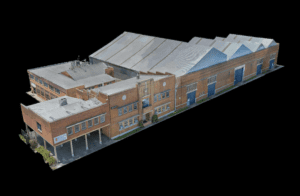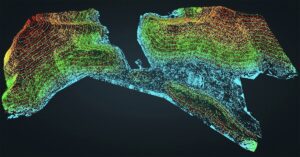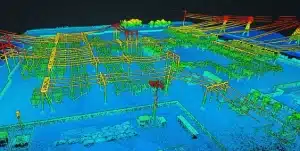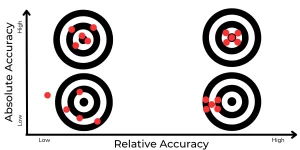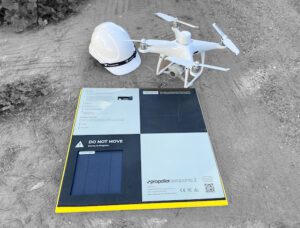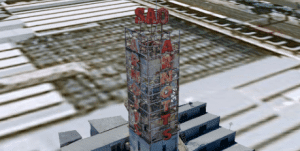Why you Should be Using Drones for Building Inspections

The understanding that drones have a huge array of commercial applications is becoming increasingly more evident. None more so than the industrial inspection industry, namely building inspections. Below we discuss how drone inspections are changing the way infrastructure is monitored and analysed for damage.
Traditional methods of inspecting building facades range from abseiling, cherry pickers, scaffolding, cranes and zoom camera lenses from other elevated areas. As soon as technology had improved to a certain point, aerial drone inspections have proven to be safer, faster, more cost efficient and also provide much higher quality data. The output allows the data to be used to create detailed and accurate dilapidation reports and create effective processes to maintain structures.
Benefits of Using Drones for Building Inspections
Safety
The main benefit of drone building inspections are that it can prevent injury or death by preventing the need for a human to be in a risky situation. Accessing facades on mid to high rise buildings pose incredible risk for those involved and even more so when other factors are taken into account such as wet surfaces, electrical power supplies and faulty equipment. Drones take all of this out of the equation and are able to complete the job effectively with zero risk to human life.
Access

The facades of buildings and structures can be extremely difficult to access. There may be obstructions or features of the building which make it difficult and dangerous. Generally, it’s harder to gain access to structures without erecting scaffolding or using elevated work platforms or using rope access. Buildings that have overhangs and narrow crevices can prove hard to get a proper visual. A drone operator is able to manoeuvre the remotely piloted aircraft to gain access to almost any part of a building with the use of high-resolution zoom cameras. Another great feature is that if there is a requirement to go back to the same area for another look it’s much easier to get access than via other traditional methods. Drones also are much better at hovering in a single area with incredible stability even in moderate to high winds.
Cost Effective
It’s not a secret that drones greatly reduce the cost of acquiring high quality data to determine the condition of infrastructure. Factors that contribute to this are;
- Less risk which lowers the cost of insurance for equipment and public liability
- Drone inspections are conducted in a fraction of the time which reduces time on site required to complete
- Typically, there are also less personnel required
- Equipment is less expensive than cranes, elevated work platforms and costly rope access systems. Using drones compared with having to erect scaffold can save more than 80% in cost (Source: In Building tech)
Quality of Data
Being able to put themselves in awkward positions on the building facades can be difficult using traditional methods. Then they have to properly assess and either take photos or notes of the area. This can limit effectiveness greatly not only due to not being able to see the area well but also because they are focusing on the dangerous situation they are in which can detract from the task at hand. High resolution cameras with zoom lenses which can be positioned at any angle or height allows for high quality imagery to be able to properly assess the condition of all areas of the facade. If there is a large project and you have an abseiler along the façade for long periods of time who is thirsty, tired and losing concentration, not only is this dangerous but it also reduces the quality of work they are able to achieve. Several assessors may be required for mid to large projects which can cause inconsistencies in the data provided.
These well equipped remotely piloted aircraft are capable of carrying custom payloads such as high resolution cameras as well as thermal and lidar sensors which provides a level of detail never seen before on any other method. Geo referenced images via the installed GPS in the units also make it easy for shots to be taken at a later date in the exact same spot to compare change over time. Sophisticated drone infrastructure inspection software assists building owners to create visual inspection reports to easily determine the location of images on the building. An inspector can also be safely on the ground with their own screen getting a live feed directing the drone operator and making notes as they go. This is a much more comfortable way to determine irregularities and anomalies. The data can then also be taken into the office and looked at in more detail to see fine cracks and other damage that could easily be missed out on the site.
Efficiency

Projects that can take days or weeks can be completed in a sliver of the time using task specific inspection drones. Being able to easily position themselves with such high-quality cameras and sensors allows incredibly quick acquisition of data at a quality which cannot be matched with manned access. The time it takes to set up cranes, elevated work platforms, rope access can make a huge impact on the time it takes to complete a job not to mention the difficulty of moving around the structure.
Technology is improving exponentially in the drone industry allowing them to be more stable by use of accurate GPS, PPK and RTK systems as well as less susceptible to electromagnetic interference. This allows them to be even safer and a more viable option. Also, with the rapid improvement of high-resolution low light cameras and other sensors such as lidar and thermal cameras they are becoming a necessary part of many companies processes in order to maintain, report and repair infrastructure. This means that because costs are reduced, aerial inspections are able to be undertaken more frequently which allows building owners to repair problem areas before they become worse which can be much more costly and also dangerous.
For more information on how you can introduce drones to inspect your buildings and other infrastructure over time, you can connect with one of our experts at High Exposure. We are here to make your aerial inspection process simple, affordable and effective.


